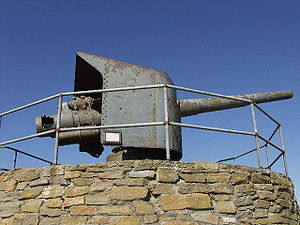15 cm Schnelladekanone L/45
| 15 cm SK L/45 | |
|---|---|
 Gun salvaged from SMS Bremse, at the Scapa Flow Visitor Centre, Hoy, Orkney Islands, UK. © Copyright Peter Mattock and licensed for reuse under this Creative Commons Licence | |
| Type | naval gun railroad gun coast defense gun |
| Place of origin | Germany |
| Service history | |
| In service | 1908—1945 |
| Used by | |
| Wars | World War I, World War II |
| Production history | |
| Designer | Krupp |
| Designed | 1906—08 |
| Manufacturer | Krupp |
| Specifications | |
| Barrel length | 6.71 metres (264 in) |
| | |
| Shell | separate-loading, case charge |
| Caliber | 149.1 millimetres (5.87 in) |
| Breech | horizontal sliding-wedge |
| Recoil | hydro-spring |
| Muzzle velocity | 840 metres per second (2,800 ft/s) |
The 15 cm SK L/45 (15 cm Schnelladekanone (quick-loading gun)) 45 caliber) was a German naval gun used in World War I and World War II.
Contents
This gun was fitted as the casemate-mounted secondary armament in all Imperial German dreadnought battleships and battlecruisers, the armored cruiser SMS Blücher and as primary armament in the Pillau, Wiesbaden, Königsberg, Köln-class light cruisers and Brummer-class minelaying cruisers. After World War I it was fitted to the light cruiser Emden. It was also fitted to German merchant raiders during World War II.
| Type of Mount | Designation | Weight | Elevation | Range (during World War I) | Ship Classes |
| Single pedestal mounts in casemates | MPL C/06 | 15,770 kilograms (34,770 lb) | -7° to +20° | 14,900 metres (16,300 yd) | Nassau, Helgoland, Kaiser, von der Tann, Moltke, Blücher |
| MPL C/06.11 | 16,533 kilograms (36,449 lb) | -10° to +19° | 13,500 metres (14,800 yd) | König, Seydlitz, Derfflinger | |
| MPL C/13 | 17,950 kilograms (39,570 lb) | -8.5° to +19 | 13,500 metres (14,800 yd) | Bayern, Hindenburg, Mackensen | |
| MPL C/13 mod | 18,350 kilograms (40,450 lb) | -8.5° to +22 | 15,800 metres (17,300 yd) | Wartime modification to MPL C/13 | |
| Single pedestal mounts in open half-shields | MPL C/14 | 16,185 kilograms (35,682 lb) | -10° to +22° | 15,800 metres (17,300 yd) | Wiesbaden, Königsberg |
| MPL C/16 | 17,116 kilograms (37,734 lb) | -10° to +27° | 16,800 metres (18,400 yd) | Köln, Emden | |
| MPL C/16 mod | -10° to +30 | 17,600 metres (19,200 yd) | wartime modification to MPL C/16 |
Ammunition
It used 45.3 kilograms (100 lb) 15 cm Spgr L/4.1 HE shells with a bursting charge weight between 3.9 kilograms (8.6 lb) and 4.09 kilograms (9.0 lb), depending on how the shell was fuzed.
Coast Defense Gun
The same gun was used for coast defense duties in concrete emplacements after World War I. One example was 3./Marine-Artillerie Abteilung 604 (3rd Battery of Naval Artillery Battalion 604) on the Isle of Jersey[1]. They show it using 44 kilograms (97 lb) shells with a range of 18,000 metres (20,000 yd)
Railroad Gun
It was also used as a railroad gun during World War I.
See also
- BL 6 inch Mk XII naval gun British equivalent
References
- Gander, Terry and Chamberlain, Peter. Weapons of the Third Reich: An Encyclopedic Survey of All Small Arms, Artillery and Special Weapons of the German Land Forces 1939-1945. New York: Doubleday, 1979 ISBN 0-385-15090-3
External links
Notes
- ↑ Gander and Chamberlain, p. 266
Template:WWIGermanShipsTemplate:Germany-mil-stub
| This artillery-related article is a stub. You can help ssf by expanding it. |